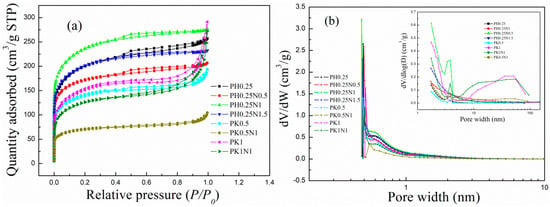-
 Membrane-Disruptive Effects of Fatty Acid and Monoglyceride Mitigants on E. coli Bacteria-Derived Tethered Lipid Bilayers
Membrane-Disruptive Effects of Fatty Acid and Monoglyceride Mitigants on E. coli Bacteria-Derived Tethered Lipid Bilayers -
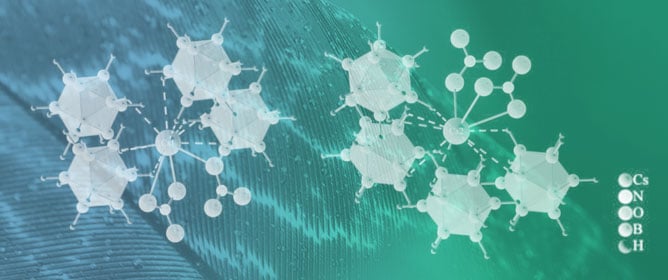 Synthesis and Characterization of First High-Energy Anti-Perovskite Compounds by Hydro-Closo-Borate and Oxo-Anions
Synthesis and Characterization of First High-Energy Anti-Perovskite Compounds by Hydro-Closo-Borate and Oxo-Anions -
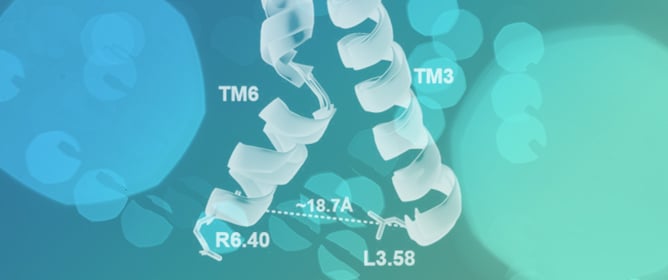 Mechanisms of Peptide Binding and Deactivation of Adhesion GPCR
Mechanisms of Peptide Binding and Deactivation of Adhesion GPCR -
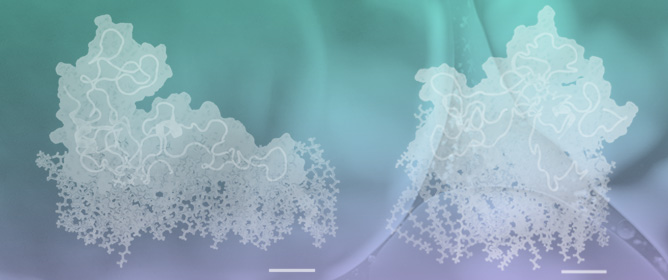 Multiscale Modeling of Macromolecular Interactions between Tau-Amylin Oligomers and Asymmetric Lipid Nanodomains That Link Alzheimer’s and Diabetic Diseases
Multiscale Modeling of Macromolecular Interactions between Tau-Amylin Oligomers and Asymmetric Lipid Nanodomains That Link Alzheimer’s and Diabetic Diseases -
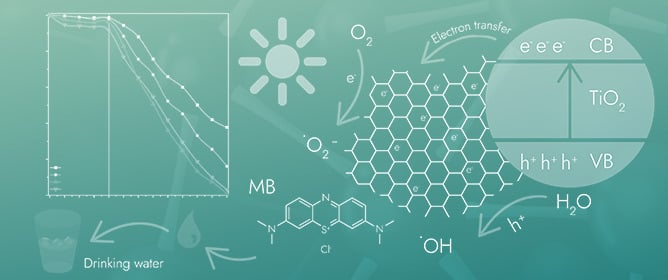 Synergistic Remediation of Organic Dye by Titanium Dioxide/Reduced Graphene Oxide Nanocomposite
Synergistic Remediation of Organic Dye by Titanium Dioxide/Reduced Graphene Oxide Nanocomposite
Journal Description
Molecules
Molecules
is the leading international, peer-reviewed, open access journal of chemistry. Molecules is published semimonthly online by MDPI. The International Society of Nucleosides, Nucleotides & Nucleic Acids (IS3NA), the Spanish Society of Medicinal Chemistry (SEQT) and the International Society of Heterocyclic Chemistry (ISHC) are affiliated with Molecules and their members receive a discount on the article processing charges.
- Open Access— free for readers, with article processing charges (APC) paid by authors or their institutions.
- High Visibility: indexed within Scopus, SCIE (Web of Science), PubMed, MEDLINE, PMC, Reaxys, CaPlus / SciFinder, MarinLit, AGRIS, and other databases.
- Journal Rank: JCR - Q2 (Chemistry, Multidisciplinary) / CiteScore - Q1 (Chemistry (miscellaneous))
- Rapid Publication: manuscripts are peer-reviewed and a first decision is provided to authors approximately 14.6 days after submission; acceptance to publication is undertaken in 2.7 days (median values for papers published in this journal in the second half of 2023).
- Recognition of Reviewers: reviewers who provide timely, thorough peer-review reports receive vouchers entitling them to a discount on the APC of their next publication in any MDPI journal, in appreciation of the work done.
- Sections: published in 26 topical sections.
- Testimonials: See what our editors and authors say about Molecules.
- Companion journals for Molecules include: Foundations and Photochem.
Impact Factor:
4.6 (2022);
5-Year Impact Factor:
4.9 (2022)
Latest Articles
The Resource Utilization of Poplar Leaves for CO2 Adsorption
Molecules 2024, 29(9), 2024; https://0-doi-org.brum.beds.ac.uk/10.3390/molecules29092024 (registering DOI) - 27 Apr 2024
Abstract
►
Show Figures
Every late autumn, fluttering poplar leaves scatter throughout the campus and city streets. In this work, poplar leaves were used as the raw material, while H3PO4 and KOH were used as activators and urea was used as the nitrogen source
[...] Read more.
Every late autumn, fluttering poplar leaves scatter throughout the campus and city streets. In this work, poplar leaves were used as the raw material, while H3PO4 and KOH were used as activators and urea was used as the nitrogen source to prepare biomass based-activated carbons (ACs) to capture CO2. The pore structures, functional groups and morphology, and desorption performance of the prepared ACs were characterized; the CO2 adsorption, regeneration, and kinetics were also evaluated. The results showed that H3PO4 and urea obviously promoted the development of pore structures and pyrrole nitrogen (N–5), while KOH and urea were more conductive to the formation of hydroxyl (–OH) and ether (C–O) functional groups. At optimal operating conditions, the CO2 adsorption capacity of H3PO4– and KOH–activated poplar leaves after urea treatment reached 4.07 and 3.85 mmol/g, respectively, at room temperature; both showed stable regenerative behaviour after ten adsorption–desorption cycles.
Full article
Open AccessArticle
Heat-Insulated Regenerated Fibers with UV Resistance: Silk Fibroin/Al2O3 Nanoparticles
by
Jianjun Guo, Song Lu, Yi Zhou, Yuanyuan Yang, Xiaoxian Yao and Guohua Wu
Molecules 2024, 29(9), 2023; https://0-doi-org.brum.beds.ac.uk/10.3390/molecules29092023 (registering DOI) - 27 Apr 2024
Abstract
►▼
Show Figures
The various wastes generated by silkworm silk textiles that are no longer in use are increasing, which is causing considerable waste and contamination. This issue has attracted widespread attention in countries that use a lot of silk. Therefore, enhancing the mechanical properties of
[...] Read more.
The various wastes generated by silkworm silk textiles that are no longer in use are increasing, which is causing considerable waste and contamination. This issue has attracted widespread attention in countries that use a lot of silk. Therefore, enhancing the mechanical properties of regenerated silk fibroin (RSF) and enriching the function of silk are important directions to expand the comprehensive utilization of silk products. In this paper, the preparation of RSF/Al2O3 nanoparticles (NPs) hybrid fiber with different Al2O3 NPs contents by wet spinning and its novel performance are reported. It was found that the RSF/Al2O3 NPs hybrid fiber was a multifunctional fiber material with thermal insulation and UV resistance. Natural light tests showed that the temperature rise rate of RSF/Al2O3 NPs hybrid fibers was slower than that of RSF fibers, and the average temperature rose from 29.1 °C to about 35.4 °C in 15 min, while RSF fibers could rise to about 40.1 °C. UV absorption tests showed that the hybrid fiber was resistant to UV radiation. Furthermore, the addition of Al2O3 NPs may improve the mechanical properties of the hybrid fibers. This was because the blending of Al2O3 NPs promoted the self-assembly of β-sheets in the RSF reaction mixture in a dose-dependent manner, which was manifested as the RSF/Al2O3 NPs hybrid fibers had more β-sheets, crystallinity, and a smaller crystal size. In addition, RSF/Al2O3 NPs hybrid fibers had good biocompatibility and durability in micro-alkaline sweat environments. The above performance makes the RSF/Al2O3 NPs hybrid fibers promising candidates for application in heat-insulating and UV-resistant fabrics as well as military clothing.
Full article
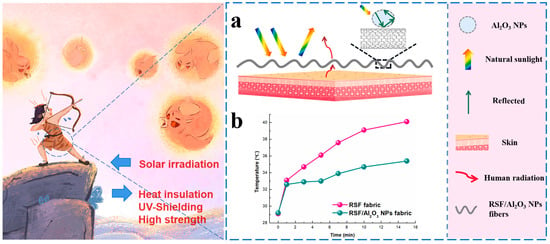
Figure 1
Open AccessReview
Tailoring FXR Modulators for Intestinal Specificity: Recent Progress and Insights
by
Amanda Morrison and Bahaa Elgendy
Molecules 2024, 29(9), 2022; https://0-doi-org.brum.beds.ac.uk/10.3390/molecules29092022 (registering DOI) - 27 Apr 2024
Abstract
While FXR has shown promise in regulating bile acid synthesis and maintaining glucose and lipid homeostasis, undesired side effects have been observed in clinical trials. To address this issue, the development of intestinally restricted FXR modulators has gained attention as a new avenue
[...] Read more.
While FXR has shown promise in regulating bile acid synthesis and maintaining glucose and lipid homeostasis, undesired side effects have been observed in clinical trials. To address this issue, the development of intestinally restricted FXR modulators has gained attention as a new avenue for drug design with the potential for safer systematic effects. Our review examines all currently known intestinally restricted FXR ligands and provides insights into the steps taken to enhance intestinal selectivity.
Full article
(This article belongs to the Section Medicinal Chemistry)
►▼
Show Figures
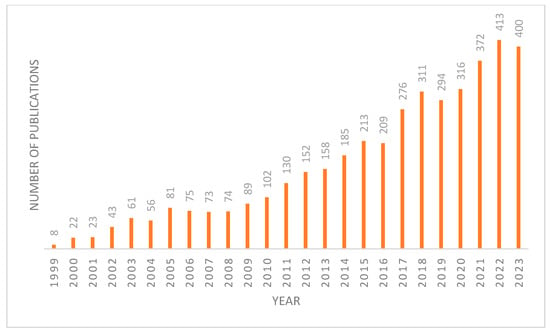
Figure 1
Open AccessReview
Bioremediation of Hazardous Pollutants Using Enzyme-Immobilized Reactors
by
Hiroshi Yamaguchi and Masaya Miyazaki
Molecules 2024, 29(9), 2021; https://0-doi-org.brum.beds.ac.uk/10.3390/molecules29092021 (registering DOI) - 27 Apr 2024
Abstract
Bioremediation uses the degradation abilities of microorganisms and other organisms to remove harmful pollutants that pollute the natural environment, helping return it to a natural state that is free of harmful substances. Organism-derived enzymes can degrade and eliminate a variety of pollutants and
[...] Read more.
Bioremediation uses the degradation abilities of microorganisms and other organisms to remove harmful pollutants that pollute the natural environment, helping return it to a natural state that is free of harmful substances. Organism-derived enzymes can degrade and eliminate a variety of pollutants and transform them into non-toxic forms; as such, they are expected to be used in bioremediation. However, since enzymes are proteins, the low operational stability and catalytic efficiency of free enzyme-based degradation systems need improvement. Enzyme immobilization methods are often used to overcome these challenges. Several enzyme immobilization methods have been applied to improve operational stability and reduce remediation costs. Herein, we review recent advancements in immobilized enzymes for bioremediation and summarize the methods for preparing immobilized enzymes for use as catalysts and in pollutant degradation systems. Additionally, the advantages, limitations, and future perspectives of immobilized enzymes in bioremediation are discussed.
Full article
(This article belongs to the Special Issue Modern Trends of Biocatalysis in Organic Chemistry and Enzyme Engineering–2nd Edition)
►▼
Show Figures
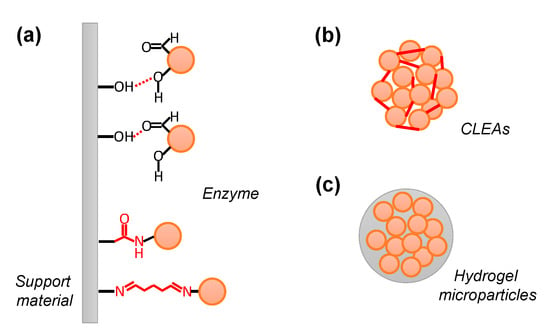
Figure 1
Open AccessReview
Azulene and Its Derivatives as Potential Compounds in the Therapy of Dermatological and Anticancer Diseases: New Perspectives against the Backdrop of Current Research
by
Emilia Slon, Bartosz Slon and Dorota Kowalczuk
Molecules 2024, 29(9), 2020; https://0-doi-org.brum.beds.ac.uk/10.3390/molecules29092020 (registering DOI) - 27 Apr 2024
Abstract
The scientific article focuses on the role of azulene and its derivatives in the therapy of dermatological diseases, presenting the latest laboratory and clinical research as well as prospects for further studies. In a synthetic literature review, various databases such as PubMed, Scopus,
[...] Read more.
The scientific article focuses on the role of azulene and its derivatives in the therapy of dermatological diseases, presenting the latest laboratory and clinical research as well as prospects for further studies. In a synthetic literature review, various databases such as PubMed, Scopus, Web of Science, and the Database of Polish Scientific Journals were queried to select relevant articles concerning azulene. The conclusions drawn from the thematic analysis of the studies emphasize the multifaceted pharmacological actions of azulene and its derivatives including their anti-inflammatory properties, potential anticancer effects, photoprotective abilities, alleviation of itching, management of atopic dermatitis, and treatment of erectile dysfunction. However, there are certain limitations associated with the application of unmodified azulene on the skin, particularly related to photodecomposition and the generation of reactive oxygen species under UV radiation. These effects, in turn, necessitate further research on the safety of azulene and azulene-derived substances, especially regarding their long-term use and potential application in phototherapy. The authors of this work emphasize the necessity of conducting further preclinical and clinical studies to fully understand the mechanisms of action. Incorporating azulene and its derivatives into the therapy of dermatological disorders may represent an innovative approach, thereby opening new treatment avenues for patients.
Full article
(This article belongs to the Special Issue Natural Products and Analogues with Promising Biological Profiles)
►▼
Show Figures
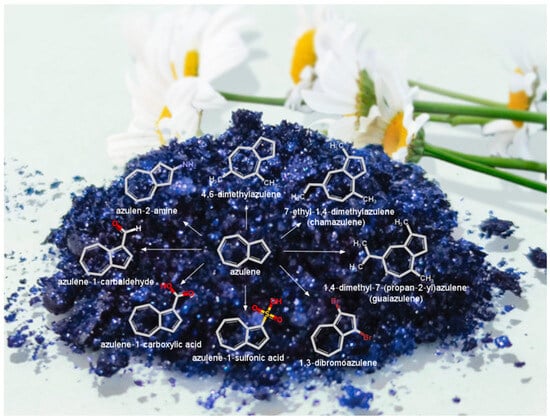
Figure 1
Open AccessArticle
Microencapsulation of Essential Oils Using Faba Bean Protein and Chia Seed Polysaccharides via Complex Coacervation Method
by
Alicja Napiórkowska, Arkadiusz Szpicer, Elżbieta Górska-Horczyczak and Marcin Andrzej Kurek
Molecules 2024, 29(9), 2019; https://0-doi-org.brum.beds.ac.uk/10.3390/molecules29092019 (registering DOI) - 27 Apr 2024
Abstract
The aim of this study was to develop microcapsules containing juniper or black pepper essential oils, using a combination of faba bean protein and chia seed polysaccharides (in ratios of 1:1, 1:2, 2:1). By synergizing these two polymers, our goal was to enhance
[...] Read more.
The aim of this study was to develop microcapsules containing juniper or black pepper essential oils, using a combination of faba bean protein and chia seed polysaccharides (in ratios of 1:1, 1:2, 2:1). By synergizing these two polymers, our goal was to enhance the efficiency of essential oil microencapsulation, opening up various applications in the food industry. Additionally, we aimed to investigate the influence of different polymer mixing ratios on the properties of the resulting microcapsules and the course of the complex coacervation process. To dissolve the essential oils and limit their evaporation, soybean and rapeseed oils were used. The powders resulting from the freeze-drying of coacervates underwent testing to assess microencapsulation efficiency (65.64–87.85%), density, flowability, water content, solubility, and hygroscopicity. Additionally, FT-IR and DSC analyses were conducted. FT-IR analysis confirmed the interactions between the components of the microcapsules, and these interactions were reflected in their high thermal resistance, especially at a protein-to-polysaccharide ratio of 2:1 (177.2 °C). The water content in the obtained powders was low (3.72–7.65%), but it contributed to their hygroscopicity (40.40–76.98%).
Full article
(This article belongs to the Special Issue New Technologies for Encapsulation of Small Molecules and Plant Extracts II)
►▼
Show Figures
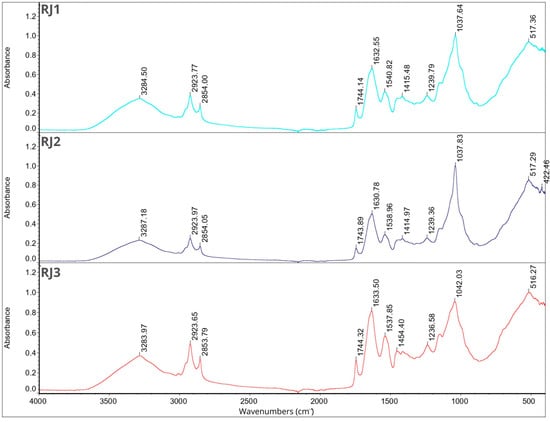
Figure 1
Open AccessArticle
Physicochemical Properties of Inorganic and Hybrid Hydroxyapatite-Based Granules Modified with Citric Acid or Polyethylene Glycol
by
Ewelina Cichoń, Karolina Kosowska, Piotr Pańtak, Joanna P. Czechowska, Aneta Zima and Anna Ślósarczyk
Molecules 2024, 29(9), 2018; https://0-doi-org.brum.beds.ac.uk/10.3390/molecules29092018 (registering DOI) - 27 Apr 2024
Abstract
This study delves into the physicochemical properties of inorganic hydroxyapatite (HAp) and hybrid hydroxyapatite–chitosan (HAp-CTS) granules, also gold-enriched, which can be used as aggregates in biomicroconcrete-type materials. The impact of granules’ surface modifications with citric acid (CA) or polyethylene glycol (PEG) was assessed.
[...] Read more.
This study delves into the physicochemical properties of inorganic hydroxyapatite (HAp) and hybrid hydroxyapatite–chitosan (HAp-CTS) granules, also gold-enriched, which can be used as aggregates in biomicroconcrete-type materials. The impact of granules’ surface modifications with citric acid (CA) or polyethylene glycol (PEG) was assessed. Citric acid modification induced increased specific surface area and porosity in inorganic granules, contrasting with reduced parameters in hybrid granules. PEG modification resulted in a slight increase in specific surface area for inorganic granules and a substantial rise for hybrid granules with gold nanoparticles. Varied effects on open porosity were observed based on granule type. Microstructural analysis revealed increased roughness for inorganic granules post CA modification, while hybrid granules exhibited smoother surfaces. Novel biomicroconcretes, based on α-tricalcium phosphate (α-TCP) calcium phosphate cement and developed granules as aggregates within, were evaluated for compressive strength. Compressive strength assessments showcased significant enhancement with PEG modification, emphasizing its positive impact. Citric acid modification demonstrated variable effects, depending on granule composition. The incorporation of gold nanoparticles further enriched the multifaceted approach to enhancing calcium phosphate-based biomaterials for potential biomedical applications. This study demonstrates the pivotal role of surface modifications in tailoring the physicochemical properties of granules, paving the way for advanced biomicroconcretes with improved compressive strength for diverse biomedical applications.
Full article
(This article belongs to the Special Issue Biomaterials Based on Calcium Phosphates and Their Modifications)
►▼
Show Figures
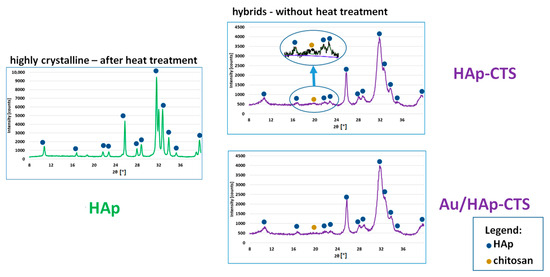
Figure 1
Open AccessFeature PaperReview
Borane–Trimethylamine Complex: A Versatile Reagent in Organic Synthesis
by
Dario Perdicchia
Molecules 2024, 29(9), 2017; https://0-doi-org.brum.beds.ac.uk/10.3390/molecules29092017 (registering DOI) - 27 Apr 2024
Abstract
►▼
Show Figures
Borane–trimethylamine complex (Me3N·BH3; BTM) is the most stable of the amine–borane complexes that are commercially available, and it is cost-effective. It is a valuable reagent in organic chemistry with applications in the reduction of carbonyl groups and carbon–nitrogen double
[...] Read more.
Borane–trimethylamine complex (Me3N·BH3; BTM) is the most stable of the amine–borane complexes that are commercially available, and it is cost-effective. It is a valuable reagent in organic chemistry with applications in the reduction of carbonyl groups and carbon–nitrogen double bond reduction, with considerable examples in the reduction of oximes, hydrazones and azines. The transfer hydrogenation of aromatic N-heterocycles and the selective N-monomethylation of primary anilines are further examples of recent applications, whereas the reduction of nitrobenzenes to anilines and the reductive deprotection of N-tritylamines are useful tools in the organic synthesis. Moreover, BTM is the main reagent in the regioselective cleavage of cyclic acetals, a reaction of great importance for carbohydrate chemistry. Recent innovative applications of BTM, such as CO2 utilization as feedstock and radical chemistry by photocatalysis, have extended their usefulness in new reactions. The present review is focused on the applications of borane–trimethylamine complex as a reagent in organic synthesis and has not been covered in previous reviews regarding amine–borane complexes.
Full article
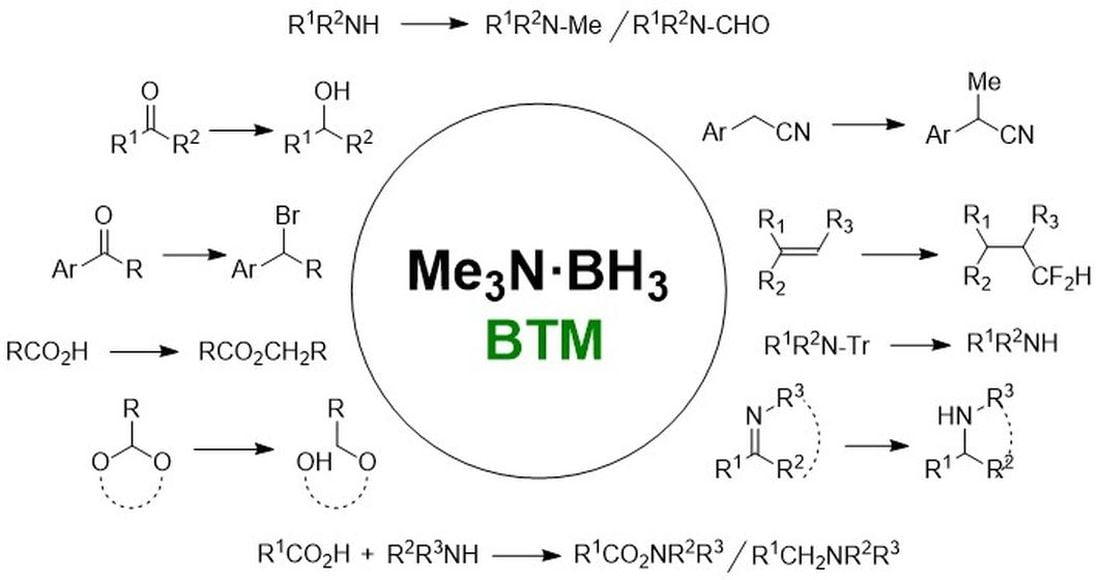
Graphical abstract
Open AccessArticle
Reactive Force Field Molecular Dynamics Investigation of NH3 Generation Mechanism during Protein Pyrolysis Process
by
Shuai Guo, Yu Wang, Shujun Zhu, Hongwei Qu, Deng Zhao, Xingcan Li and Yan Zhao
Molecules 2024, 29(9), 2016; https://0-doi-org.brum.beds.ac.uk/10.3390/molecules29092016 (registering DOI) - 27 Apr 2024
Abstract
The mechanism of ammonia formation during the pyrolysis of proteins in biomass is currently unclear. To further investigate this issue, this study employed the AMS 2023.104 software to select proteins (actual proteins) as the model compounds and the amino acids contained within them
[...] Read more.
The mechanism of ammonia formation during the pyrolysis of proteins in biomass is currently unclear. To further investigate this issue, this study employed the AMS 2023.104 software to select proteins (actual proteins) as the model compounds and the amino acids contained within them (assembled amino acids) as the comparative models. ReaxFF molecular dynamics simulations were conducted to explore the nitrogen transformation and NH3 generation mechanisms in three-phase products (char, tar, and gas) during protein pyrolysis. The research results revealed several key findings. Regardless of whether the model compounds are actual proteins or assembled amino acids, NH3 is the primary nitrogen-containing product during pyrolysis. However, as the temperature rises to higher levels, such as 2000 K and 2500 K, the amount of NH3 decreases significantly in the later stages of pyrolysis, indicating that it is being converted into other nitrogen-bearing species, such as HCN and N2. Simultaneously, we also observed significant differences between the pyrolysis processes of actual proteins and assembled amino acids. Notably, at 2000 K, the amount of NH3 generated from the pyrolysis of assembled amino acids was twice that of actual proteins. This discrepancy mainly stems from the inherent structural differences between proteins and amino acids. In proteins, nitrogen is predominantly present in a network-like structure (NH-N), which shields it from direct external exposure, thus requiring more energy for nitrogen to participate in pyrolysis reactions, making it more difficult for NH3 to form. Conversely, assembled amino acids can release NH3 through a simpler deamination process, leading to a significant increase in NH3 production during their pyrolysis.
Full article
(This article belongs to the Special Issue Renewable Energy, Fuels and Chemicals from Biomass)
►▼
Show Figures
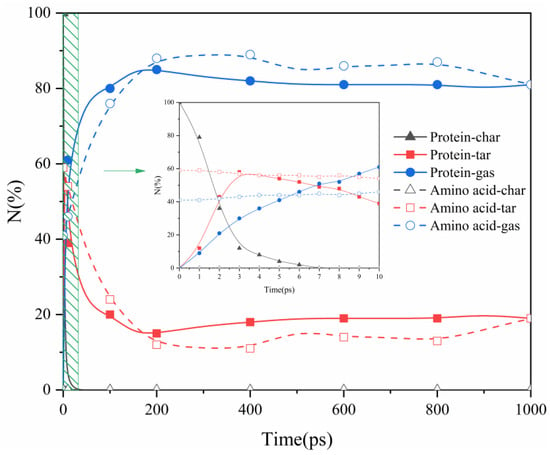
Figure 1
Open AccessFeature PaperArticle
Absorption and Fluorescence Emission Investigations on Supramolecular Assemblies of Tetrakis-(4-sulfonatophenyl)porphyrin and Graphene Quantum Dots
by
Mariachiara Sarà, Salvatore Vincenzo Giofrè, Salvatore Abate, Mariachiara Trapani, Rosaria Verduci, Giovanna D’Angelo, Maria Angela Castriciano, Andrea Romeo, Giovanni Neri and Luigi Monsù Scolaro
Molecules 2024, 29(9), 2015; https://0-doi-org.brum.beds.ac.uk/10.3390/molecules29092015 (registering DOI) - 27 Apr 2024
Abstract
The one-pot synthesis of N-doped graphene quantum dots (GQDs), capped with a positively charged polyamine (trien), has been realized through a microwave-assisted pyrolysis on solid L-glutamic acid and trien in equimolar amounts. The resulting positively charged nanoparticles are strongly emissive in aqueous solutions
[...] Read more.
The one-pot synthesis of N-doped graphene quantum dots (GQDs), capped with a positively charged polyamine (trien), has been realized through a microwave-assisted pyrolysis on solid L-glutamic acid and trien in equimolar amounts. The resulting positively charged nanoparticles are strongly emissive in aqueous solutions and are stable for months. The interaction with the anionic tetrakis(4-sulphonatophenyl)porphyrin (TPPS4) has been investigated at neutral and mild acidic pH using a combination of UV/vis absorption spectroscopy together with static and time-resolved fluorescence emission. At pH = 7, the experimental evidence points to the formation of a supramolecular adduct mainly stabilized by electrostatic interactions. The fluorescence emission of the porphyrin is substantially quenched while GQDs remain still emissive. On decreasing the pH, protonation of TPPS4 leads to formation of porphyrin J-aggregates through the intermediacy of the charged quantum dots.
Full article
(This article belongs to the Section Physical Chemistry)
Open AccessFeature PaperReview
Polyphenols of the Inuleae-Inulinae and Their Biological Activities: A Review
by
Janusz Malarz, Klaudia Michalska and Anna Stojakowska
Molecules 2024, 29(9), 2014; https://0-doi-org.brum.beds.ac.uk/10.3390/molecules29092014 (registering DOI) - 27 Apr 2024
Abstract
Polyphenols are ubiquitous plant metabolites that demonstrate biological activities essential to plant–environment interactions. They are of interest to plant food consumers, as well as to the food, pharmaceutical and cosmetic industry. The class of the plant metabolites comprises both widespread (chlorogenic acids, luteolin,
[...] Read more.
Polyphenols are ubiquitous plant metabolites that demonstrate biological activities essential to plant–environment interactions. They are of interest to plant food consumers, as well as to the food, pharmaceutical and cosmetic industry. The class of the plant metabolites comprises both widespread (chlorogenic acids, luteolin, quercetin) and unique compounds of diverse chemical structures but of the common biosynthetic origin. Polyphenols next to sesquiterpenoids are regarded as the major class of the Inuleae-Inulinae metabolites responsible for the pharmacological activity of medicinal plants from the subtribe (Blumea spp., Dittrichia spp., Inula spp., Pulicaria spp. and others). Recent decades have brought a rapid development of molecular and analytical techniques which resulted in better understanding of the taxonomic relationships within the Inuleae tribe and in a plethora of data concerning the chemical constituents of the Inuleae-Inulinae. The current taxonomical classification has introduced changes in the well-established botanical names and rearranged the genera based on molecular plant genetic studies. The newly created chemical data together with the earlier phytochemical studies may provide some complementary information on biochemical relationships within the subtribe. Moreover, they may at least partly explain pharmacological activities of the plant preparations traditionally used in therapy. The current review aimed to systematize the knowledge on the polyphenols of the Inulae-Inulinae.
Full article
(This article belongs to the Special Issue Natural Polyphenols in Human Health (Volume II))
►▼
Show Figures

Graphical abstract
Open AccessArticle
Total Content and Composition of Phenolic Compounds from Filipendula Genus Plants and Their Potential Health-Promoting Properties
by
Ekaterina Sokolova, Tatiana Krol, Grigorii Adamov, Yulia Minyazeva, Dmitry Baleev and Nikolay Sidelnikov
Molecules 2024, 29(9), 2013; https://0-doi-org.brum.beds.ac.uk/10.3390/molecules29092013 (registering DOI) - 27 Apr 2024
Abstract
This current article was dedicated to the determination of the composition of phenolic compounds in extracts of four species of the genus Filipendula in order to establish a connection between the composition of polyphenols and biological effects. A chemical analysis revealed that the
[...] Read more.
This current article was dedicated to the determination of the composition of phenolic compounds in extracts of four species of the genus Filipendula in order to establish a connection between the composition of polyphenols and biological effects. A chemical analysis revealed that the composition of the extracts studied depended both on the plant species and its part (leaf or flower) and on the extractant used. All four species of Filipendula were rich sources of phenolic compounds and contained hydrolyzable tannins, condensed tannins, phenolic acids and their derivatives, and flavonoids. The activities included data on those that are most important for creating functional foods with Filipendula plant components: the influence on blood coagulation measured by prothrombin and activated partial thromboplastin time, and on the activity of the digestive enzymes (pancreatic amylase and lipase). It was established that plant species, their parts, and extraction methods contribute meaningfully to biological activity. The most prominent result is as follows: the plant organ determines the selective inhibition of either amylase or lipase; thus, the anticoagulant activities of F. camtschatica and F. stepposa hold promise for health-promoting food formulations associated with general metabolic disorders.
Full article
(This article belongs to the Special Issue Probing Pharmacological and Biological Performance of Synthetic and Natural Compounds—2nd Edition)
►▼
Show Figures
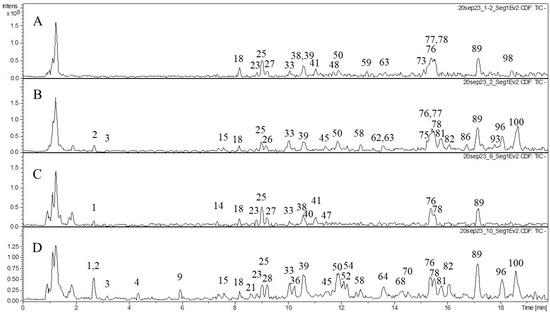
Figure 1
Open AccessArticle
Alginate Films Enriched in Raspberry and/or Black Currant Seed Oils as Active Food Packaging
by
Jolanta Kowalonek, Bogna Łukomska, Olga Łukomska and Natalia Stachowiak-Trojanowska
Molecules 2024, 29(9), 2012; https://0-doi-org.brum.beds.ac.uk/10.3390/molecules29092012 (registering DOI) - 27 Apr 2024
Abstract
Alginate films plasticized with glycerol and enriched in raspberry and/or black currant seed oils were prepared via casting solution techniques. The intention was to create active films for food packaging where antioxidants in a film would deactivate oxidants in a packed product or
[...] Read more.
Alginate films plasticized with glycerol and enriched in raspberry and/or black currant seed oils were prepared via casting solution techniques. The intention was to create active films for food packaging where antioxidants in a film would deactivate oxidants in a packed product or its surroundings, improving conditions inside packaging and extending the shelf life of such a product. The prepared materials were characterized by physicochemical, spectroscopic, mechanical, water vapor transmission (WVTR), and antioxidant activity analysis. Infrared spectra of the alginate films with oils were similar to those without the additive; the band with a maximum at about 1740 cm−1 stood out. The prepared materials with oils were thicker, contained less water, were more yellow, and were less permeable to water vapor. Moreover, the presence of the oil in the films resulted in a slightly lower Young’s modulus and lower stress at break values but higher strain at break. The antioxidant capacity of raspberry seed oil itself was about five times higher than that of black currant seed oil, and a similar trend was noticed for films modified with these oils. The results indicated that both oils could be used as active substances with antioxidant properties in food packaging.
Full article
(This article belongs to the Special Issue Polysaccharide-Based Biopolymer: Recent Development and Applications)
►▼
Show Figures
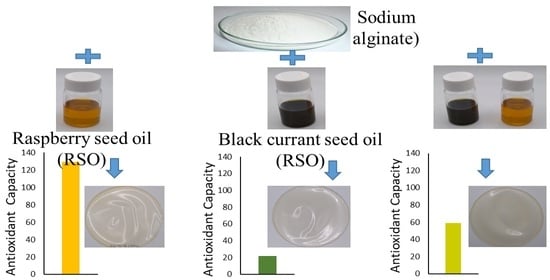
Graphical abstract
Open AccessArticle
Objective Quantification Technique and Widely Targeted Metabolomics-Based Analysis of the Effects of Different Saccharidation Processes on Preserved French Plums
by
Shengkun Yan, Rong Dong, Jiapeng Yang and Guoqiang Wang
Molecules 2024, 29(9), 2011; https://0-doi-org.brum.beds.ac.uk/10.3390/molecules29092011 (registering DOI) - 26 Apr 2024
Abstract
Vacuum saccharification significantly affected the flavor and color of preserved French plums. However, the correlation between color, flavor, and metabolites remains unclear. Metabolites contribute significantly to enhancing the taste and overall quality of preserved French plums. This study aimed to investigate the distinctive
[...] Read more.
Vacuum saccharification significantly affected the flavor and color of preserved French plums. However, the correlation between color, flavor, and metabolites remains unclear. Metabolites contribute significantly to enhancing the taste and overall quality of preserved French plums. This study aimed to investigate the distinctive metabolites in samples from various stages of the processing of preserved French plums. The PCF4 exhibited the highest appearance, overall taste, and chroma. Furthermore, utilizing UPLC and ESI-Q TRAP-MS/MS, a comprehensive examination of the metabolome in the processing of preserved French plums was conducted. A total of 1776 metabolites were analyzed. Using WGCNA, we explored metabolites associated with sensory features through 10 modules. Based on this, building the correlation of modules and objective quantification metrics yielded three key modules. After screening for 151 differentiated metabolites, amino acids, and their derivatives, phenolic acids, flavonoids, organic acids, and other groups were identified as key differentiators. The response of differential metabolites to stress influenced the taste and color properties of preserved prunes. Based on these analyses, six important metabolic pathways were identified. This study identified changes in the sensory properties of sugar-stained preserved prunes and their association with metabolite composition, providing a scientific basis for future work to improve the quality of prune processing.
Full article
Open AccessSystematic Review
Systematic Review of Chemical Compounds with Immunomodulatory Action Isolated from African Medicinal Plants
by
Wendwaoga Arsène Nikiema, Moussa Ouédraogo, Windbedma Prisca Ouédraogo, Souleymane Fofana, Boris Honoré Amadou Ouédraogo, Talwendpanga Edwige Delma, Belem Amadé, Gambo Moustapha Abdoulaye, Aimé Serge Sawadogo, Raogo Ouédraogo and Rasmané Semde
Molecules 2024, 29(9), 2010; https://0-doi-org.brum.beds.ac.uk/10.3390/molecules29092010 (registering DOI) - 26 Apr 2024
Abstract
A robust, well-functioning immune system is the cornerstone of good health. Various factors may influence the immune system’s effectiveness, potentially leading to immune system failure. This review aims to provide an overview of the structure and action of immunomodulators isolated from African medicinal
[...] Read more.
A robust, well-functioning immune system is the cornerstone of good health. Various factors may influence the immune system’s effectiveness, potentially leading to immune system failure. This review aims to provide an overview of the structure and action of immunomodulators isolated from African medicinal plants. The research was conducted according to PRISMA guidelines. Full-text access research articles published in English up to December 2023, including plant characteristics, isolated phytochemicals, and immuno-modulatory activities, were screened. The chemical structures of the isolated compounds were generated using ChemDraw® (version 12.0.1076), and convergent and distinctive signaling pathways were highlighted. These phytochemicals with demonstrated immunostimulatory activity include alkaloids (berberine, piperine, magnoflorine), polysaccharides (pectin, glucan, acemannan, CALB-4, GMP90-1), glycosides (syringin, cordifolioside, tinocordiside, aucubin), phenolic compounds (ferulic acid, vanillic acid, eupalitin), flavonoids (curcumin, centaurein, kaempferin, luteolin, guajaverin, etc.), terpenoids (oleanolic acid, ursolic acid, betulinic acid, boswellic acids, corosolic acid, nimbidin, andrographolides). These discussed compounds exert their effects through various mechanisms, targeting the modulation of MAPKs, PI3K-Akt, and NF-kB. These mechanisms can support the traditional use of medicinal plants to treat immune-related diseases. The outcomes of this overview are to provoke structural action optimization, to orient research on particular natural chemicals for managing inflammatory, infectious diseases and cancers, or to boost vaccine immunogenicity.
Full article
(This article belongs to the Special Issue Natural Bioactive Compounds and Human Health)
Open AccessArticle
Green Preparation and Antibacterial Activity Evaluation of AgNPs-Blumea balsamifera Oil Nanoemulsion
by
Chunfang Ma, Bingnan Liu, Lingfeng Du, Wei Liu, Yue Zhu, Teng Chen, Zuhua Wang, Hongpeng Chen and Yuxin Pang
Molecules 2024, 29(9), 2009; https://0-doi-org.brum.beds.ac.uk/10.3390/molecules29092009 (registering DOI) - 26 Apr 2024
Abstract
Bacterial infection is a thorny problem, and it is of great significance to developing green and efficient biological antibacterial agents that can replace antibiotics. This study aimed to rapidly prepare a new type of green antibacterial nanoemulsion containing silver nanoparticles in one step
[...] Read more.
Bacterial infection is a thorny problem, and it is of great significance to developing green and efficient biological antibacterial agents that can replace antibiotics. This study aimed to rapidly prepare a new type of green antibacterial nanoemulsion containing silver nanoparticles in one step by using Blumea balsamifera oil (BBO) as an oil phase and tea saponin (TS) as a natural emulsifier and reducing agent. The optimum preparation conditions of the AgNPs@BBO-TS NE were determined, as well as its physicochemical properties and antibacterial activity in vitro being investigated. The results showed that the average particle size of the AgNPs@BBO-TS NE was 249.47 ± 6.23 nm, the PDI was 0.239 ± 0.003, and the zeta potential was −35.82 ± 4.26 mV. The produced AgNPs@BBO-TS NE showed good stability after centrifugation and 30-day storage. Moreover, the AgNPs@BBO-TS NE had an excellent antimicrobial effect on Staphylococcus aureus, Escherichia coli, and Pseudomonas aeruginosa. These results demonstrated that the AgNPs@BBO-TS NE produced in this study can be used as an efficient and green antibacterial agent in the biomedical field.
Full article
Open AccessArticle
Maillard Reaction-Derived S-doped Carbon Dots Promotes Downregulation of PPARγ, C/EBPα, and SREBP-1 Genes In-Vitro
by
Hanaa Hisham Habelreeh, Jegan Athinarayanan, Vaiyapuri Subbarayan Periasamy and Ali A. Alshatwi
Molecules 2024, 29(9), 2008; https://0-doi-org.brum.beds.ac.uk/10.3390/molecules29092008 (registering DOI) - 26 Apr 2024
Abstract
Carbon nanodots (CDs) are commonly found in food products and have attracted significant attention from food scientists. There is a high probability of CD exposure in humans, but its impacts on health are unclear. Therefore, health effects associated with CD consumption should be
[...] Read more.
Carbon nanodots (CDs) are commonly found in food products and have attracted significant attention from food scientists. There is a high probability of CD exposure in humans, but its impacts on health are unclear. Therefore, health effects associated with CD consumption should be investigated. In this study, we attempted to create a model system of the Maillard reaction between cystine and glucose using a simple cooking approach. The CDs (CG-CDs) were isolated from cystine-glucose-based Maillard reaction products and characterized using fluorescence spectroscopy, X-ray diffractometer (XRD), and transmission electron microscope (TEM). Furthermore, human mesenchymal stem cells (hMCs) were used as a model to unravel the CDs’ cytotoxic properties. The physiochemical assessment revealed that CG-CDs emit excitation-dependent fluorescence and possess a circular shape with sizes ranging from 2 to 13 nm. CG-CDs are predominantly composed of carbon, oxygen, and sulfur. The results of the cytotoxicity evaluation indicate good biocompatibility, where no severe toxicity was observed in hMCs up to 400 μg/mL. The DPPH assay demonstrated that CDs exert potent antioxidant abilities. The qPCR analysis revealed that CDs promote the downregulation of the key regulatory genes, PPARγ, C/EBPα, SREBP-1, and HMGCR, coupled with the upregulation of anti-inflammatory genes. Our findings suggested that, along with their excellent biocompatibility, CG-CDs may offer positive health outcomes by modulating critical genes involved in lipogenesis, homeostasis, and obesity pathogenesis.
Full article
(This article belongs to the Topic Natural Products in Prevention and Therapy of Metabolic Syndrome)
►▼
Show Figures
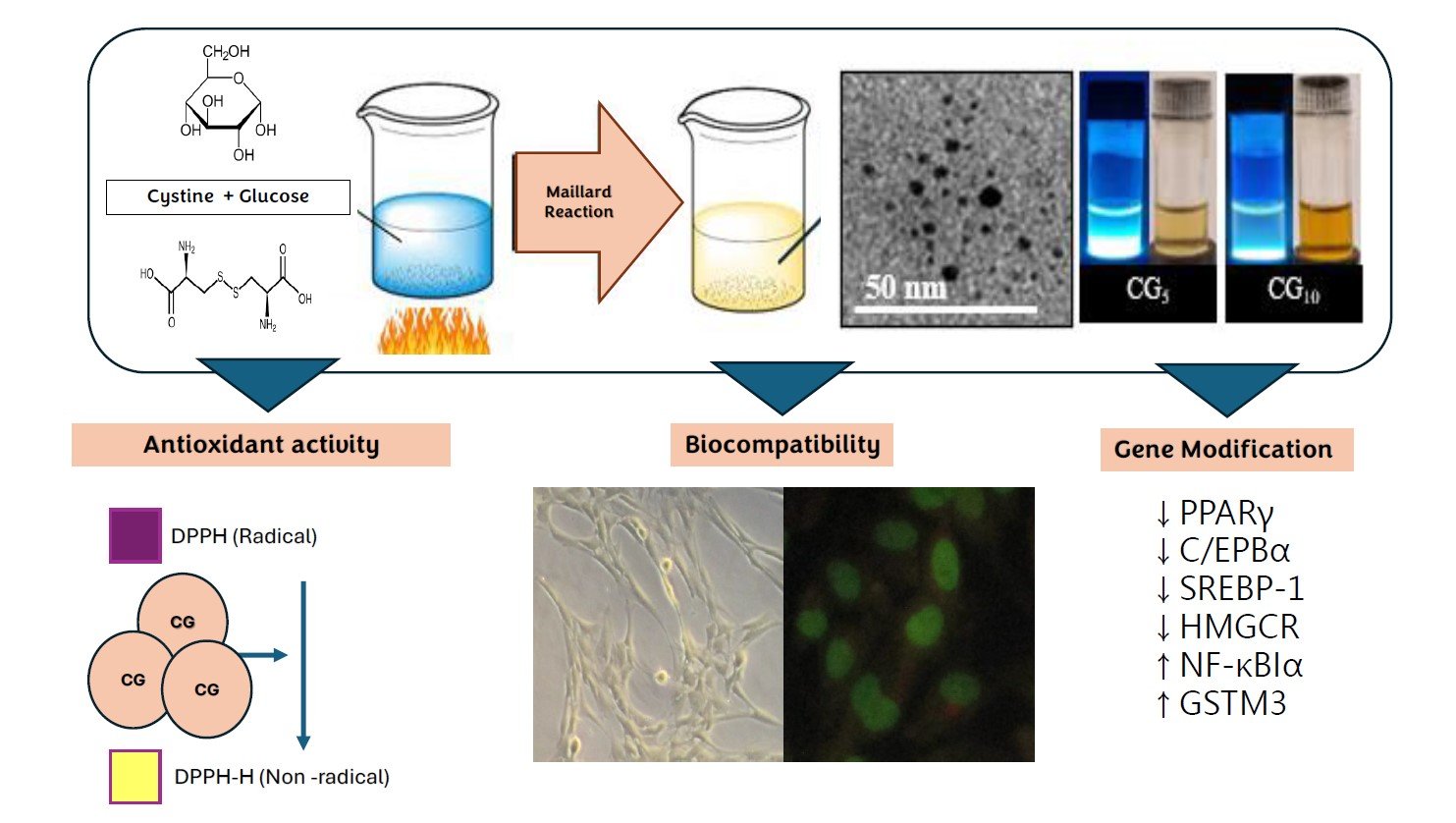
Graphical abstract
Open AccessReview
Pharmacological Potential of Kaempferol, a Flavonoid in the Management of Pathogenesis via Modulation of Inflammation and Other Biological Activities
by
Faris Alrumaihi, Saleh A. Almatroodi, Hajed Obaid A. Alharbi, Wanian M. Alwanian, Fadiyah A. Alharbi, Ahmad Almatroudi and Arshad Husain Rahmani
Molecules 2024, 29(9), 2007; https://0-doi-org.brum.beds.ac.uk/10.3390/molecules29092007 - 26 Apr 2024
Abstract
Natural products and their bioactive compounds have been used for centuries to prevent and treat numerous diseases. Kaempferol, a flavonoid found in vegetables, fruits, and spices, is recognized for its various beneficial properties, including its antioxidant and anti-inflammatory potential. This molecule has been
[...] Read more.
Natural products and their bioactive compounds have been used for centuries to prevent and treat numerous diseases. Kaempferol, a flavonoid found in vegetables, fruits, and spices, is recognized for its various beneficial properties, including its antioxidant and anti-inflammatory potential. This molecule has been identified as a potential means of managing different pathogenesis due to its capability to manage various biological activities. Moreover, this compound has a wide range of health-promoting benefits, such as cardioprotective, neuroprotective, hepatoprotective, and anti-diabetic, and has a role in maintaining eye, skin, and respiratory system health. Furthermore, it can also inhibit tumor growth and modulate various cell-signaling pathways. In vivo and in vitro studies have demonstrated that this compound has been shown to increase efficacy when combined with other natural products or drugs. In addition, kaempferol-based nano-formulations are more effective than kaempferol treatment alone. This review aims to provide detailed information about the sources of this compound, its bioavailability, and its role in various pathogenesis. Although there is promising evidence for its ability to manage diseases, it is crucial to conduct further investigations to know its toxicity, safety aspects, and mechanism of action in health management.
Full article
(This article belongs to the Special Issue Bioactive Molecules Targeting Inflammation Processes in Related Diseases—2nd Edition)
Open AccessArticle
Novel Star-Shaped Viologens Containing Phenyl and Triphenylamine Moieties for Electrochromic Applications
by
Radosław Banasz and Monika Wałęsa-Chorab
Molecules 2024, 29(9), 2006; https://0-doi-org.brum.beds.ac.uk/10.3390/molecules29092006 - 26 Apr 2024
Abstract
The two star-shaped viologens containing 1,3,5-substituted phenyl (1) and triphenylamine (2) central cores and n-hexyl chains were synthesized and characterized. Both compounds exhibited promising optoelectronic properties and underwent multiple oxidation/reduction processes resulting in various colors. Four possible redox
[...] Read more.
The two star-shaped viologens containing 1,3,5-substituted phenyl (1) and triphenylamine (2) central cores and n-hexyl chains were synthesized and characterized. Both compounds exhibited promising optoelectronic properties and underwent multiple oxidation/reduction processes resulting in various colors. Four possible redox states of tripyridium salt containing a phenyl or triphenylamine core can occur depending on the applied potentials. The wide color range, from colorless through blue, azure to green-gray, was observed during the electrochemical reduction of compound 1. In the case of compound 2, the color change observed during spectroelectrochemical measurements was from yellow to colorless during the cathodic process and from yellow to green during the anodic process. The observed color change for both viologens was reversible. The triphenylamine-cored viologen (2) also exhibited emission in visible range and solvatochromism. It also exhibited luminescence in the solid state when excited with a UV lamp. These studies provide insights into the design of advanced materials for applications in displays.
Full article
(This article belongs to the Special Issue Feature Papers in Photochemistry and Photocatalysis)
Open AccessReview
Potential Targets of Natural Products for Improving Cardiac Ischemic Injury: The Role of Nrf2 Signaling Transduction
by
Haixia Wang, Juanjuan Han, Gorbachev Dmitrii and Xin-an Zhang
Molecules 2024, 29(9), 2005; https://0-doi-org.brum.beds.ac.uk/10.3390/molecules29092005 - 26 Apr 2024
Abstract
Myocardial ischemia is the leading cause of health loss from cardiovascular disease worldwide. Myocardial ischemia and hypoxia during exercise trigger the risk of sudden exercise death which, in severe cases, will further lead to myocardial infarction. The Nrf2 transcription factor is an important
[...] Read more.
Myocardial ischemia is the leading cause of health loss from cardiovascular disease worldwide. Myocardial ischemia and hypoxia during exercise trigger the risk of sudden exercise death which, in severe cases, will further lead to myocardial infarction. The Nrf2 transcription factor is an important antioxidant regulator that is extensively engaged in biological processes such as oxidative stress, inflammatory response, apoptosis, and mitochondrial malfunction. It has a significant role in the prevention and treatment of several cardiovascular illnesses, since it can control not only the expression of several antioxidant genes, but also the target genes of associated pathological processes. Therefore, targeting Nrf2 will have great potential in the treatment of myocardial ischemic injury. Natural products are widely used to treat myocardial ischemic diseases because of their few side effects. A large number of studies have shown that the Nrf2 transcription factor can be used as an important way for natural products to alleviate myocardial ischemia. However, the specific role and related mechanism of Nrf2 in mediating natural products in the treatment of myocardial ischemia is still unclear. Therefore, this review combs the key role and possible mechanism of Nrf2 in myocardial ischemic injury, and emphatically summarizes the significant role of natural products in treating myocardial ischemic symptoms, thus providing a broad foundation for clinical transformation.
Full article
(This article belongs to the Special Issue Bioactive Natural Products for Prevention and Treatment of Cancer, Cardiovascular and Neurodegenerative Diseases, and Aging)
►▼
Show Figures
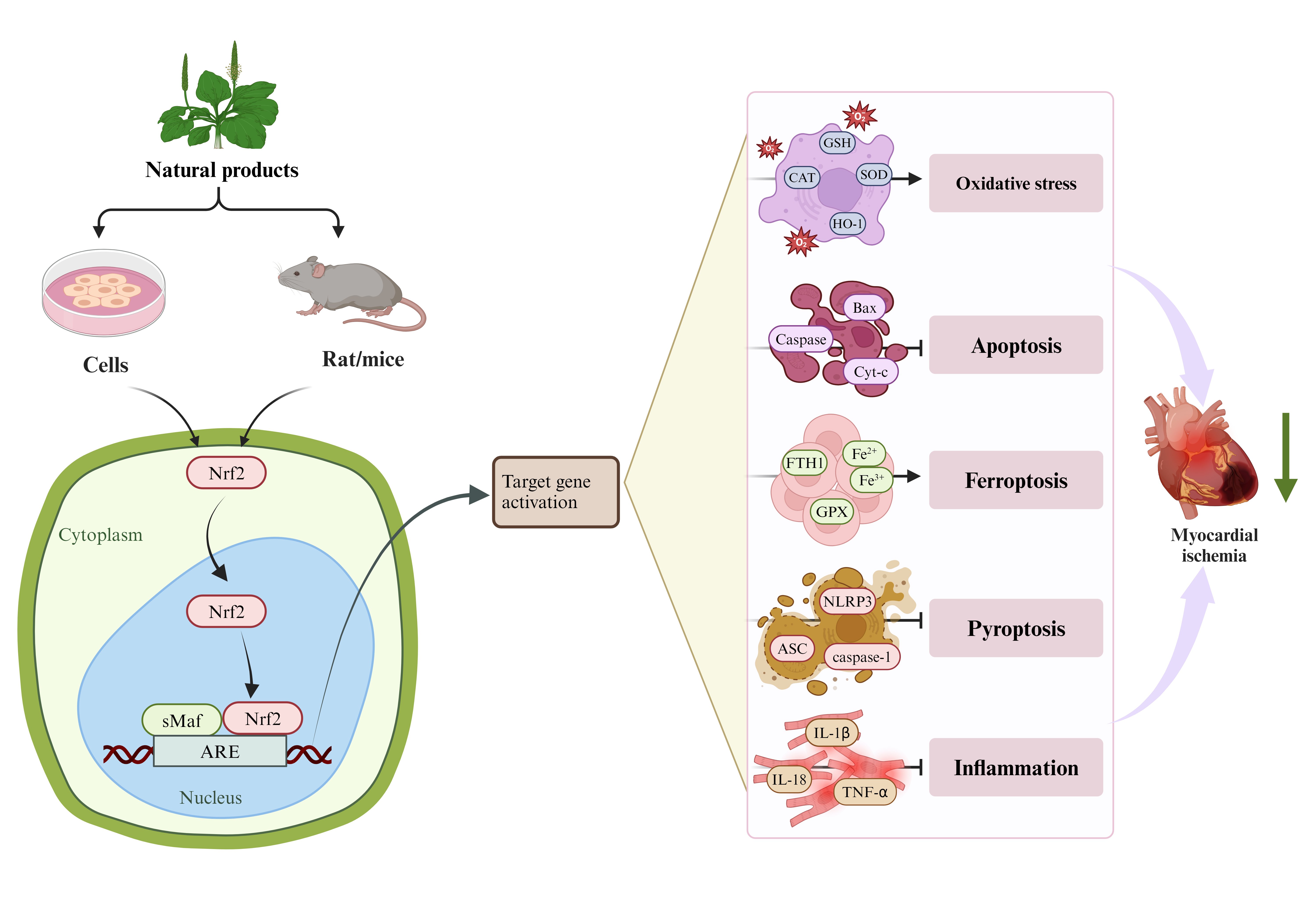
Graphical abstract

Journal Menu
► ▼ Journal Menu-
- Molecules Home
- Aims & Scope
- Editorial Board
- Reviewer Board
- Topical Advisory Panel
- Instructions for Authors
- Special Issues
- Topics
- Sections & Collections
- Article Processing Charge
- Indexing & Archiving
- Editor’s Choice Articles
- Most Cited & Viewed
- Journal Statistics
- Journal History
- Journal Awards
- Society Collaborations
- Conferences
- Editorial Office
Journal Browser
► ▼ Journal Browser-
arrow_forward_ios
Forthcoming issue
arrow_forward_ios Current issue - Vol. 29 (2024)
- Vol. 28 (2023)
- Vol. 27 (2022)
- Vol. 26 (2021)
- Vol. 25 (2020)
- Vol. 24 (2019)
- Vol. 23 (2018)
- Vol. 22 (2017)
- Vol. 21 (2016)
- Vol. 20 (2015)
- Vol. 19 (2014)
- Vol. 18 (2013)
- Vol. 17 (2012)
- Vol. 16 (2011)
- Vol. 15 (2010)
- Vol. 14 (2009)
- Vol. 13 (2008)
- Vol. 12 (2007)
- Vol. 11 (2006)
- Vol. 10 (2005)
- Vol. 9 (2004)
- Vol. 8 (2003)
- Vol. 7 (2002)
- Vol. 6 (2001)
- Vol. 5 (2000)
- Vol. 4 (1999)
- Vol. 3 (1998)
- Vol. 2 (1997)
- Volumes not published by MDPI
Highly Accessed Articles
Latest Books
E-Mail Alert
News
10 April 2024
Meet Us at the 18th International Symposium on Macrocyclic and Supramolecular Chemistry, 6–10 May 2024, Hangzhou, China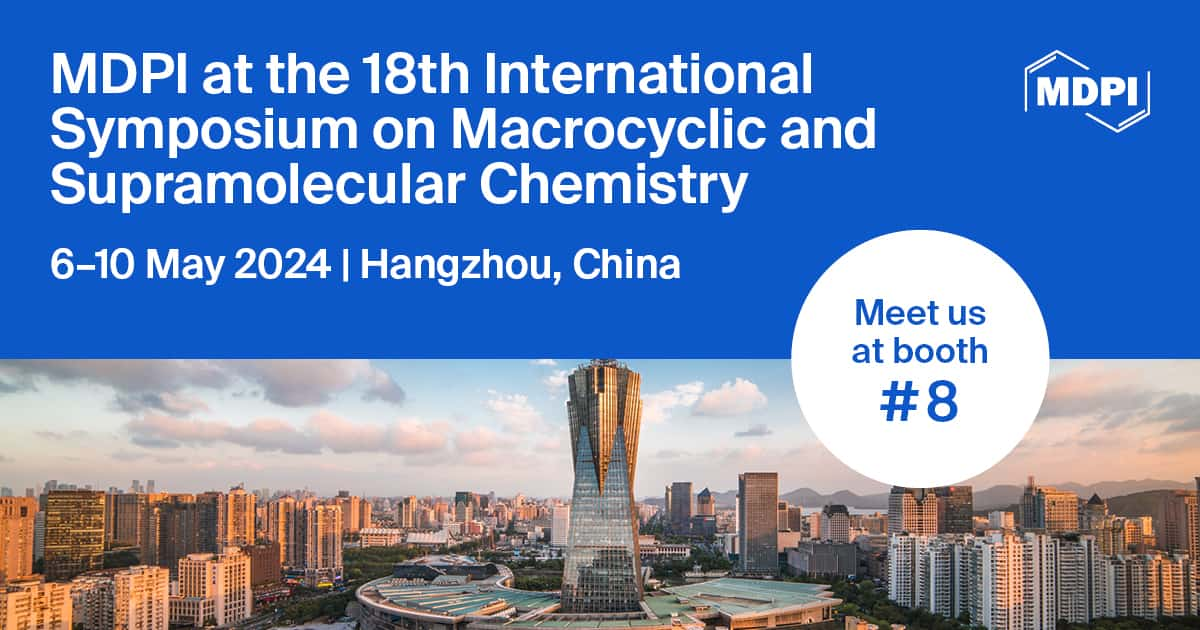
Meet Us at the 18th International Symposium on Macrocyclic and Supramolecular Chemistry, 6–10 May 2024, Hangzhou, China

Topics
Topic in
Antioxidants, IJPB, Molecules, Pharmaceuticals, Plants
Plants Volatile Compounds
Topic Editors: Dario Kremer, Igor Jerković, Valerija DunkićDeadline: 30 April 2024
Topic in
Energies, Molecules, Nanomaterials, Separations, Sustainability
Carbon Capture Science & Technology (CCST)
Topic Editors: Zilong Liu, Meixia Shan, Yakang JinDeadline: 15 May 2024
Topic in
Beverages, Fermentation, Foods, Molecules, Separations
Advances in Analysis of Flavors and Fragrances: Chemistry, Properties and Applications in Food Quality Improvement
Topic Editors: Ana Leahu, Marìa Soledad Prats Moya, Cristina GhineaDeadline: 31 May 2024
Topic in
BioChem, Biomedicines, Biomolecules, IJMS, Metabolites, Molecules
Natural Products in Prevention and Therapy of Metabolic Syndrome
Topic Editors: Jianbo Wan, Ligen LinDeadline: 30 June 2024

Conferences
Special Issues
Special Issue in
Molecules
Modulation and Determination of Lipases Activity
Guest Editor: Silvana CasatiDeadline: 30 April 2024
Special Issue in
Molecules
Advances in Computational Chemistry for Drug Design, Discovery and Screening
Guest Editors: Shuguang Yuan, Sławomir Filipek, Hideya NakamuraDeadline: 15 May 2024
Special Issue in
Molecules
Plant Secondary Metabolites with Health Effects: Discovery and Engineering
Guest Editors: Giuseppe Dionisio, Vittorio CalabreseDeadline: 31 May 2024
Special Issue in
Molecules
Electrochemical Sensors and Cells for Environmental Applications
Guest Editors: Naoufel Haddour, Yamina Mounia AzriDeadline: 16 June 2024
Topical Collections
Topical Collection in
Molecules
Ultrasound- and Microwave-Assisted Extraction of Bioactive Compounds
Collection Editors: Stela Jokić, Jelena Vladić
Topical Collection in
Molecules
Novel Approache of Anticancer Therapy
Collection Editor: Isabelle Mus-Veteau



